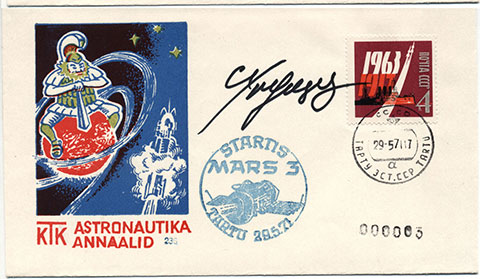Space Cover 355: Sergei Khrushchev Mars 3 coverNine days after the Mars 2 launch, on May 29, 1971, Mars 3 lifted off on a Proton rocket. It successfully landed instruments on the surface of Mars but they were destroyed in a ferocious sand storm within minutes of the landing. 236 if these covers from Tartu in the USSR were made by an individual (even though the rubber stamp is referred to as a "Club Cachet." The signature is that of Sergei Khrushchev, the son of the former leader of the Soviet Union, Nikolai Krushchev.
Several decades ago, Les Winick wrote to Kniga, the Soviet agency for foreign trade asking about Tartu cancelled envelopes for space events. They replied by stating that Tartu covers were "illegal", and Les shared that information with the Space Unit. As a result, collecting Tartu covers took a nosedive. But, what Kniga didn't tell Les was that the Soviet government had forbade the growing capitalistic trend by individuals and stamp clubs, in creating covers for Soviet space events because they were being sold, for profit, to Western dealers.
Therefore, the "CACHETS" were illegal, but the cancellations were applied at a legitimate post office and thus, that portion of the cover was a legitimate cancel. It is possible that some of the Soviet club cachets were backdated. There is no way of knowing that. But until proven otherwise, I intended to collect covers from Tartu for events that were not commemorated with cancelled covers anywhere else (except for the backdated covers made by the Kniga agency which were never used for mailing).
Sergei Khrushchev, Who Led the Development of the Proton Rocket
Sergei Khrushchev followed his interest in aerospace, a path that took him to Vladimir Chelomei's Design Bureau. There he led the development of the Proton rocket, which Chelomei had proposed as a launch vehicle for a two-man lunar flyby in 1966 and as the booster for Chelomei's proposed military space station.
However, Sergei Korolev's design bureau, led by the famous designer of the Russian ICBM and the head of the Soviet Space Program wanted the moon program themselves.. Korolev curried political favor for his role in designing the Soviet ICBM and the launching of Sputniks and other flights. But, according to Khrushchev, Korolev lacked the design resources required to win the space race — resources in which the Chelomei Design Bureau had already invested for the development of the Proton rocket. Chelomei's team was making headway on the project when Korolev had their contract cancelled in 1965, a late reversal for the Soviet Union that cost them valuable time in the Space Race, per Khrushchev. Although Korolev's meddling may have cost the Soviets the Space Race, it didn't stop work on the Proton rocket.
The Chelomei Design Bureau envisioned the Proton winning the Space Race and as a platform for the military "Zvezda" space station, but in real life it has seen use in deploying :vehicles toward Mars; civilian satellites; and modules as well a supply vehicles for the International Space Station.
Prior to emigrating from the Soviet Union to the United States in 1991, Dr. Khrushchev worked in various high-level engineering positions. From 1958 to 1968, Dr. Khrushchev worked as an engineer, then later as a deputy section head in charge of guidance systems for missile and space design. In this capacity, he worked on cruise missiles for submarine craft, military and research spacecraft, moon vehicles, and the "Proton" space booster.












